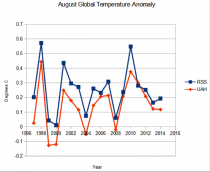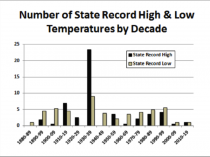Dr. Roy Spencer
With the hopes of an El Nino fading (now reduced to a 58% probability), and what could be another early start to an unusually cold and snowy winter, it is useful to take a step back and examine why some of us have been harping for years on what really controls North American climate variations on the timescale of your lifetime: natural climate cycles.
The most prominent of these are the Pacific Decadal Oscillation (PDO) and the Atlantic Multidecadal Oscillation (AMO).
Not only do these cycles profoundly influence North American climate, there is considerable evidence that they are partly responsible for that popular hobgoblin, “global warming”.
As the following graphic shows, the PDO - which was originally discovered as the main control over fisheries productivity off the west coast of North America - is also related to periods when global temperatures were rising or falling, which tend to occur over ~30 year periods:
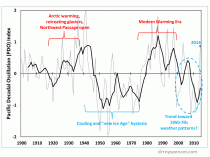
Yearly Pacific Decadal Oscillation values, and the corresponding periods of popular climate change awareness (light gray is yearly values, dark line is 4-yr trailing averages).
We aren’t sure how this happens, but small natural variations in global average cloud cover changing how much sunlight is let into the climate system are a strong possibility.
The issue is important because, to the extent that natural climate cycles are partly responsible for recent global warming, the less reason there is to be concerned about energy policies which reduce the use of fossil fuels, currently necessary for human prosperity. With today’s news that President Obama will continue to pursue executive action on climate change, while not requiring equal commitments from the largest greenhouse gas emitter China, it is important that people understand that most of what we experience in terms of weather and climate change is largely out of our control.
The trouble with including natural climate cycles in the national discussion of global warming is both political and scientific: (1) it doesn’t fit the global warming narrative driven by policy goals, and (2) we don’t understand what causes natural climate cycles, and so they cannot be included in computer climate models.
Government research funding for at least 25 years has hinged on the assumption of human causation, and as I have always said, if you fund scientists to find a connection, they will indeed find it. That’s why the resulting research that is published also is dominated by explanations involving human causation.
Nevertheless, it is fairly easy to show that natural cycles are indeed involved in not only regional changes, but “global warming” as well.
For example, the accompanying spreadsheet shows that over the most recent warming period (since the late 1970s), the PDO, AMO, and El Nino/La Nina activity can statistically account for most of the recent warming of global average sea surface temperatures.
But statistics aren’t enough. Since we understand that carbon dioxide is a greenhouse gas, and should cause some warming, but we don’t understand natural climate cycles, scientists only look where the streetlight of government funding illuminates the problem: CO2.
What complicates policymaking even further is that what motivates public perceptions and thus decision makers the most are weather events. Hurricane Sandy. A snowy winter. We end up blaming these on the only thing we thing we think we understand - increasing CO2 should cause some change, so it must be responsible for all of the change we see.
Those natural cycles - well documented in the scientific literature for at least their regional effects - are forgotten. Except by some of us who have been working in the climate field for at least a few decades. Ask Weatherbell’s Joe Bastardi, who has been talking about these natural cycles for years - and using them to make good long-range forecasts.
The recent admission that natural changes are responsible for the California drought was not news to some of us. What is news is that some pretty big research names that would be assumed to be part of the global warming bureaucracy are the ones now saying it.
So, as the unseasonal cold settles in over the U.S. this week, don’t be fooled by those who claim “global warming causes cooling”. What we are seeing is natural variability, likely dominated by the oceans. The “new weather norm” might well be different from what anyone less than 30 years old has been used to.
To the extent that human-caused warming is occurring, I am increasingly convinced it is a largely benign - and possibly beneficial - needle lost in the haystack of Mother Nature’s natural climate gyrations.
Paul Driessen
President Obama’s war on coal mines, utilities, families and communities - and on reliable, affordable energy - is well known. So is his war on the Keystone XL pipeline. Far fewer Americans are aware that his administration is also waging war on other pipelines, including those that would transport clean natural gas. (Most voters probably would not be surprised by this. They’re just not aware of it.)
My article this week explains how far this President’s regulators are going to slow or stymie pipeline construction while expediting wind, solar and other projects that have far more significant impacts on birds, bats and other wildlife than drilling, fracking and pipelines ever could.
The Obama war on pipelines
Expedite wind and solar - but block coal, oil, gas, pipelines, jobs and economic recovery
Paul Driessen
“This is not the same industry we had 15 years ago,” Natural Gas Supply Association VP Jennifer Fordham said recently. That’s an understatement. The oil, petrochemical and manufacturing industries are also far different from those of 15 years ago. Together, they’ve created hundreds of thousands of new jobs and generated countless billions of dollars in economic activity. No thanks to the Obama Administration.
From EPA to Interior and even the Energy Department, the Administration continues to display a strong animosity toward fossil fuels. Its war on coal has hounded mines, power plants, jobs and communities. Its opposition to the Keystone XL pipeline has thwarted the creation of tens of thousands of construction jobs. Its bans on leasing, drilling and hydraulic fracturing on federal onshore and offshore lands have caused a 6% drop in oil production from those lands and a 28% plunge in natural gas output - costing thousands of jobs and tens of billions in bonus, rent, royalty and tax revenues to the U.S. Treasury.
Nevertheless, you’d think Obama regulators and policy makers would support natural gas pipelines. Even the Sierra Club promoted this fuel as a “clean alternative to coal” just a couple years ago. But no.
The fracking revolution on America’s state and private lands has unleashed a gusher of mammoth proportions. In just six years, 2008-2014, it has generated a 58% increase in oil production (from 5 million to 8 million barrels per day) - and a 21% rise in natural gas production. By the end of this year, U.S. crude oil production is projected to reach 9 million bpd. In the Marcellus Shale region, gas production is expected to reach 16 billion cubic feet a day, twice the volume of only two years ago.
However, this miraculous cornucopia is overwhelming the nation’s existing delivery systems and, far from striving to eliminate the bottleneck, the Obama Administration is creating new ones.
Not having the Keystone pipeline to transport Upper Midwest crude to refineries has forced oil companies to move that oil by train. Rail accidents have caused spills and deaths, but the regulatory focus has been on stronger tanker cars, with insufficient attention paid to track maintenance and safety or pipelines.
Insufficient natural gas pipelines mean producers cannot deliver this vital fuel to homes, hospitals, factories and electricity generating plants, or to petrochemical plants that use it as a feed stock for literally thousands of products. Pipeline companies are clamoring for construction permits.
With supplies rising, prices for oil and natural gas are declining. Global crude oil prices have fallen more than $20 a barrel and are cheaper in the United States than in Europe. Natural gas prices in the Marcellus area have been about half the U.S. benchmark price, which is below $4 per thousand cubic feet (mcf), compared to prices as high as $9 or even $20 per mcf (or Btu) in Europe and Asia. As a result, despite a clear need for gas, some drillers are re-examining their Marcellus plans, and an estimated 1,750 Pennsylvania natural gas wells are not currently producing because pipeline connections are not available.
Natural gas pipelines also ensure energy conservation and reduce air pollution. A North Dakota pipeline would collect gas produced with crude oil, eliminating the need to “flare” the gas. But permit delays, largely by federal agencies, mean enough gas to heat 160,000 homes goes up in smoke every month.
Why are pipelines lagging behind production? First, pipeline companies build new capacity only when there is a demonstrated need. Second, and most important, pipeline permit approvals are being delayed.
A 2013 INGAA Foundation study found that the number of interstate natural gas pipeline authorizations issued more than 90 days after federal environmental assessments were completed climbed from 8% to 28% since Congress passed the 2005 Energy Policy Act. Rather than streamlining permits, as Congress had intended, the law had the opposite effect. It removed the Federal Energy Regulatory Commission’s ability to keep project reviews on a strict schedule, allowed both state and federal agencies to drag their heels on pipeline permitting, and opened the door to more objections by environmental pressure groups.
Authorization delays were caused by conflicts among federal agencies, as well as inadequate or under-trained agency staff, applicant changes to projects requiring additional or revised environmental review (often in response to environmentalist or other third-party protests and demands), site-access problems, and FERC and other agency reviews of requirements for mitigating asserted environmental impacts, INGAA concluded. Increased partisanship at FERC has also increased delays.
The Obama Army Corps of Engineers slowed pipeline permits by citing the Clean Water Act. Its Fish and Wildlife Service (USFWS) cited the Migratory Bird Treaty Act to justify slow-walking permits. Its Environmental Protection Agency wants to control all “waters of the United States” (WOTUS), so as to exert regulatory authority over activities on federal, state and private lands - including drilling, fracking and pipelines - in the name of sustainability, climate change prevention and other eco-mantras.
The MBTA bans the “taking” (harassing, harming, killing, capturing or wounding) of migratory birds, their nests and eggs related to natural gas pipelines and other projects. Because building a pipeline requires clearing a right-of-way, excavating and other activities that could affect wildlife for a short time, a permit is required. But native grasses soon cover the route, and state-of-the-art steel, valves and safety features greatly reduce the likelihood of ruptures and spills, compared to earlier generation pipelines.
And yet the Obama FWS drags its feet on pipeline permits - while approving numerous renewable energy projects beloved by the President and his “green” base, including massive wind turbines that slaughter millions of eagles, hawks, bats and other threatened, endangered and migratory species every year.
The FWS also blessed the huge Ivanpah Solar Electric Generating System on the Nevada/California border. It uses 300,000 mirrors to reflect the sun’s rays onto three 40-story water-filled towers to produce steam and generate electricity. Eagles, owls, falcons and other birds that fly between the solar panels and towers become “streamers,” because the 500-degree heat turns them into smoking, disintegrating corpses as they plummet to earth. There’s little left to find or bury making it easy for Big Solar regulators, operators and promoters to claim “minimal” wildlife impacts. In fact, during the Ivanpah project’s environmental review, the FWS focused on desert tortoises and missed the bird crematorium issue.
Meanwhile, the Bureau of Land Management unveiled a sweeping plan that would revise longstanding resource management plans, to install buffer zones around “sensitive” Gunnison sage grouse habitats, impose seasonal restrictions on oil and gas drilling and livestock grazing, and close roads and trails wherever grouse are present. But in the midst of this effort, BLM and various state governments are also working to streamline “eco-friendly” solar, wind, geothermal and transmission line projects that they claim will reduce “dangerous” carbon dioxide emissions. Natural gas would do that, too, of course.
Natural gas is clean, affordable and reliable - if it can reach consumers through pipelines, which are the safest form of energy transportation. Unfortunately, the Obama principle seems to be: If it requires subsidies, raises energy prices, costs jobs, impacts thousands of acres, and butchers birds and bats - expedite approval. If it generates royalty and tax revenues, produces reliable, affordable energy, creates jobs, and has minimal impacts on endangered and migratory species delay or ban it. Talk about crazy.
The administration’s fixation on ideological environmentalism is not helping the environment, the economy, or consumers. It is a political ploy designed to garner liberal votes and rake in more money from campaign donors like Tom Steyer, the billionaire hedge fund manager who got his money from coal.
America needs more pipelines. The Obama Administration needs to let industry build them. Perhaps a reconstituted Senate (with Harry Reid as Minority Leader) can lead the way. America will prosper!
Paul Driessen is senior policy analyst for the Committee For A Constructive Tomorrow (www.CFACT.org) and author of Eco-Imperialism: Green power - Black death and coauthor of Cracking Big Green: To save the world from the save-the-Earth money machine.
Anthony Cox
When the Man-Made Global Warming (AGW) scare was beginning an honest devotee Steven Guilbeault of Greenpeace said that anything proved AGW; Guilbeault stated:
Global warming can mean colder, it can mean drier, it can mean wetter, that’s what we’re dealing with.
What a theory! Nothing disproves it and everything proves it!
There have been plenty of examples to this all embracing approach since. Most recently the record breaking sea ice in the Antarctic has been in the news. It’s a real slap in the kisser for all the alarmists; how can the planet be burning to a crisp when we’ve got more ice than we can ever use in our Scotch?
_thumb.png)
But credit where credit is due, the alarmists have come up with a new paper which proves all that sea ice is due to AGW. That’s right! More ice is firm evidence of more warming. The paper is by Bintanja et al and is in Nature, where else?
Bintanja et al’s theory is that melting of the Antarctic Sheet ice [ice on land] at its base, basal, is happening and this basal melt-water is flowing into the ocean trapping hot water underneath creating an inversion whereby the trapped colder surface water freezes which gives the erroneous impression that things are colder whereas it is AGW heating which sets the whole damn thing off.
It’s a pity for Bintanja that another paper shows that instead of basal melting there is basal freezing. In fact Bell et al conclude this basal freezing is expanding the Antarctic ice sheet.
Who to believe?
Well, the air temperature in the Antarctic hasn’t risen since 1979:
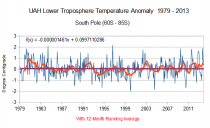
And Antarctic sea surface temperature has fallen since 2006, which would explain the extra ice:
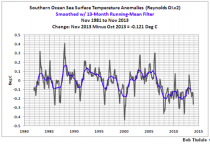
And if we look at ARGO OHC measurements in the Antarctic we see there is no warming at any level in the ocean:
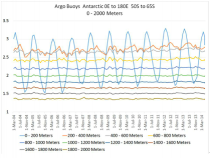
Who are we going to believe: the guys who show that it’s the cold which causes more ice in the Antarctic or the other ones who reckon the extra ice is because it’s getting warmer.
Mike Mogil CCM
WEATHERTORIAL: The following opinions are mine alone. This weathertorial was very difficult to write because, as a professional meteorologist, I have been a supporter of The Weather Channel (TWC) since its inception in 1982.
I believed in The Weather Channel when it was in its infancy, when many thought it would fail. I watched TWC religiously as it reached maturity and became a major national weather force.
And then, growing beyond its optimal bounds, and succumbing to buyouts by Comcast and NBC-Universal, I watched as the behemoth grew top-heavy with corporate bureaucrats and started to topple. Now, more than 30 years old, TWC is, in my opinion, past its prime.
Hence, as of September 24, 2014, I declared The Weather Channel off limits on my TV. I decided that if I, “needed to check the radar, babe,” (referring to my wife, who has lived with my incessant channel switching for years), I would get up, walk to my computer, and call up the local National Weather Service radar image.
There are several reasons behind this important, what I consider to be earth-shattering, decision. First, many years ago, TWC removed weather from its mainstream evening hours programming and added weather movies, special series, and other features. Yet, it was during this time period that many significant weather events were occurring. Getting real-time weather information, the primary purpose behind TWC’s existence, was compromised.
Next, The Weather Channel decided that every weather event had to have a “dark side.” I can still recall weathercasts during which the weather was picture perfect and, yet, TWC meteorologists proudly announced, “(paraphrased)...but, you could die from high UV readings.”
Then, TWC jumped into the climate change cauldron. Instead of reporting weather news and giving a balanced approach to the evolving issue, TWC opted for the NBC mantra of pushing the “green agenda.” Although I don’t buy into a human-driven climate catastrophe (because, as my wife noted, “how can we be so presumptuous as to believe that we can control such major planetary forces?"), I do subscribe to being a better planetary steward. I do this with a critical mindset (asking these and other questions):
• is the approach reasonable?
• is it cost effective?
• does it attack the real problem?
• is the solution deliverable?
• what are the downside risks?
It also quickly became apparent that The Weather Channel only reported on events that supported the human-caused climate change hypothesis. They never or rarely reported when events didn’t support it. When heat waves ensued, heat was the focus. When the polar vortex struck last winter, record cold was not the watchword, just the “unusual weather pattern.” When the summer of 2014 was chilly across the northeast and Great Lakes, TWC keyed on the heat and drought in California. I won’t even go into TWC’s biased ice cap reporting!
Further, every weather event, no matter how insignificant, is almost always tied to climate change.
Big weather events (such as the Halloween Storm of 1991) are often characterized as the only time such an event has ever happened or that the event is unprecedented. EVER? In the geologic history of the Earth? Or only in the past 50 years?
It is pretty obvious to me that TWC has swallowed the whole box of Kool-Aid as it pushes the human-caused climate change agenda at every turn. The other day, Al Roker and Stephanie Abrams went over the edge. They were reporting on the 300,000 protestors who wanted immediate governmental action to confront climate change. Ms. Abrams commented, “(paraphrased) with this type of support, we should finally be able to do something about the problem” WE?
Abrams trespassed beyond reporting and jumped well past editorial boundaries on this one. And, the result was the proverbial, “straw that broke the camel’s back.”
I wanted to watch TWC for weather - real data, real storm reports, information and more, all in one place. Instead, I was subjected to politically-based rhetoric and hidden editorials (in the guise of science), movies and series that replayed incessantly (many not even really about weather and which crowded out weather reporting), and ongoing lists of weather safety rules (ad nauseum).
Hence, I have finally decided that if TWC doesn’t want me, I don’t want it.
The Weather Channel has now been in the dark for 61 hours at the Mogil-Levine household. I think I am past missing the network, although I do regret not catching Jim Cantore, the maven of reliable weather information, as he weaves his incredible and mostly honest weather reporting.
And while TWC sinks, at least two other “weather channels” are rising (Fig. 1). One, WeatherNation, remains a poor upstart to even the olden TWC. However, the other, AccuWeather’s weather channel, set to debut sometime in the next month or so, promises, “All Weather, All The Time.” That message is a direct assault on the TWC approach or non-approach to TV weather!
It is very likely that TWC will not only be losing the likes of me as storm clouds gather on all horizons. Based on discussions with others, the loss of viewership may be far more than TWC may realize.
But, stay tuned for more information. As they say in TV land, “details at 6, 10 and 11...”
H. Michael Mogil, 2014
H. Michael Mogil is a Certified Consulting Meteorologist and Certified Broadcast Meteorologist, who lives in Naples, FL.
Joseph D’Aleo, CCM
NOAA/NASA reports that August was the warmest month on record because the oceans were the warmest ever. But contrary to the spectacular “hottest August ever” lies being propagated by NASA and NOAA -August was the coldest in five years and the second coldest in 10 years, according to far more accurate NASA satellites. NOAA and NASA climate agencies budgets depend on confirming government sponsored climate models .
There has been no warming for 18 years as of September according to satellite. NASA satellite derived sea surface temperatures in the record back to 1978 show there were 73 months warmer with the warmest in May 1998 (nearly a full degree Fahrenheit warmer than this August). Like the surface land temperatures, ocean temperature warming is being intentionally exaggerated.
Why the difference? Satellites provide an objective measure of the entire surface of the earth, land and sea. Surface data is severely contaminated by local urban and land use changes. Oceans, which cover 71% of the earth’s surface, have only been measured accurately with satellite since 1978 and later buoys since 2004.
Dr. Helmut Landsberg, the Father of Climatology was one of my mentors on urban heat effects when I taught Microclimatology in college. I authored a peer review paper assessing the many problems with surface observations including urbanization. It addressed most all of the misinformation presented in the Letter to the Editor last Friday by our friend Bruce.
In it, I link to a 2008 paper by Hadley’s Phil Jones et al., which found that contamination by urbanization in China was a very non-trivial 1C per century which but that did not cause the data centers to begin adjusting as that would have eliminated much of the politically proclaimed global warming.
In a 2009 article, Dr. Brian Stone of Georgia Tech wrote: “Across the US as a whole, approximately 50 percent of the warming that has occurred since 1950 is due to land use changes (usually in the form of clearing forest for crops or cities) rather than to the emission of greenhouse gases.”
Because of the satellite data is ground truth, the focus on data manipulation as we showed you last post shifted to cooling off the first half of the 1900s. Since the media is largely friendly to the cause, you would not hear that this September will make it 18 years of no warming globally in the satellite data set and that the models are failing miserably.
Record highs and lows tell the story that heat is not increasing. For 28 of the 50 state all-time record highs came in the 1930s and 38 before 1960 (Christy US Senate testimony). There has been more record lows than highs since the 1940s.
The trend of 90 and 100 degree days have been down for over 75 years. NOAA reported no changes in flood or drought frequency since 1900. The last two years have had the fewest total of tornadoes on record and long term trend of strong tornadoes has been down. Global hurricane activity is at a 30 year plus low. We have gone 9 years without a major landfalling hurricane in the US, by far the longest on record. Sea level rise has declined to 4 inches/century from 7 inches in the 1900s. The last two years have had the lowest number and acreage of forest fires in the record back to 1984. Snows have increased not decreased. Arctic ice rebounded 43% since 2012 even as this was the year when the ice was supposed to have disappeared. We have a record number of polar bears. This month we blew away the all-time satellite record for Antarctic sea ice extent. All the climate models are failing miserably.
The great Physicist Richard Feynman told his Cornell students that the scientific method dictates if a theory “...disagrees with experiment (or data), it’s wrong. “In that simple statement is the key to science. It doesn’t make any difference how beautiful your guess is, it doesn’t matter how smart you are, who made the guess, or what his name is...If it disagrees with experiment (data), it’s wrong. That’s all there is to it.”
The science argues the theory has failed, but politics and $165B keeps it alive.
At the rally this weekend in NYC, 120 thousand enviro radicals, Hollywood and polical ignorati converged on NYC arriving in buses and planes and leaving behind a not very green mountain of trash.
Ecologist Dr. Patrick Moore was a co-founder of Greenpeace when it focused on true humanitarian and animal cruelty causes. Back then we had real issues with air and water pollution. I was involved heavily with environmental causes and got my ABD on Atmospheric Chemistry. The movement made a sharp left turn in the 1980s. Patrick Moore told the Senate earlier this year and then made a powerful presentation you can see on HCTV explaining why he left Greenpeace when radicals and extremists with other agendas (population control, eliminating fossil fuels/nuclear, destroying capitalism, one world government) abandoned humanitarian efforts and railed against man as the enemy of the planet took control of Greenpeace and most all Environmental groups. Over time they adopted global warming as a tool. Patrick wrote about the new environmental radicalism.
It is a powerful convergence of interests among a very large number of elites, including politicians who want to make it seem as though they’re saving the world, environmentalists who want to raise money and get control over very large issues like our entire energy policy, media, for sensationalism, Universities and professors for grants. You can’t hardly get a science grant these days without saying it has something to do with climate change.
It is a kind of nasty combination of extreme political ideology and a religious cult all rolled into one, and it’s taken over way too much of our thought process and way too much of our priorities. There are millions of children dying every day from preventable vitamin deficiencies and diseases, and we are spending hundreds of billions of dollars on a problem that may not exist.
Some clear thinking politicians on the left see through the fog:
Democrat Climate Statistics Professor Dr. Caleb Rossiter of American University: “Obama has long been delusional on this issue. Anyone who believes we are in a climate catastrophe I think is deluding themselves.’ I’ve been lonely working on the Hill for the Democratic Party.”
Steven E. Koonin, Undersecretary for Science during Obama’s first term, sees “climate science” as a tangle of arrogance, conjecture and dubious methods that cannot withstand the scrutiny of any reasonably sharp mind.
Next story will focus on the upcoming winter and why big government sources will again not get the forecast right.
IPCC official Ottmar Edenhofer in November 2010 admitted “one has to free oneself from the illusion that international climate policy is environmental policy.” Instead, climate change policy is about how
we redistribute de facto the world’s wealth...”
By Tom Harris and Bob Carter
September 14, 2014 | 8:25pm
In the runup to the Sept. 23 UN Climate Summit in New York, Leonardo DiCaprio is releasing a series of films about the “climate crisis.”
The first is “Carbon,” which tells us the world is threatened by a “carbon monster.” Coal, oil, natural gas and other carbon-based forms of energy are causing dangerous climate change and must be turned off as soon as possible, DiCaprio says.
But he has identified the wrong monster. It is the climate scare itself that is the real threat to civilization.
DiCaprio is an actor, not a scientist; it’s no real surprise that his film is sensationalistic and error-riddled. Other climate-change fantasists, who do have a scientific background, have far less excuse.
Science is never settled, but the current state of “climate change” science is quite clear: There is essentially zero evidence that carbon dioxide from human activities is causing catastrophic climate change.
Yes, the “executive summary” of reports from the UN’s International Panel on Climate Change continues to sound the alarm - but the summary is written by the politicians. The scientific bulk of the report, while still tinged with improper advocacy, has all but thrown in the towel.
And the Nongovernmental International Panel on Climate Change lists thousands of scientific papers that either debunk or cast serious doubt on the supposed “consensus” model.
Oregon-based physicist Gordon Fulks sums it up well: “CO2 is said to be responsible for global warming that is not occurring, for accelerated sea-level rise that is not occurring, for net glacial and sea ice melt that is not occurring...and for increasing extreme weather that is not occurring.”
Consider:
According to NASA satellites and all ground-based temperature measurements, global warming ceased in the late 1990s. This when CO2 levels have risen almost 10 percent since 1997. The post-1997 CO2 emissions represent an astonishing 30 percent of all human-related emissions since the Industrial Revolution began. That we’ve seen no warming contradicts all CO2-based climate models upon which global-warming concerns are founded.
Rates of sea-level rise remain small and are even slowing, over recent decades averaging about 1 millimeter per year as measured by tide gauges and 2 to 3 mm/year as inferred from “adjusted” satellite data. Again, this is far less than what the alarmists suggested.
Satellites also show that a greater area of Antarctic sea ice exists now than any time since space-based measurements began in 1979. In other words, the ice caps aren’t melting.
A 2012 IPCC report concluded that there has been no significant increase in either the frequency or intensity of extreme weather events in the modern era. The NIPCC 2013 report concluded the same. Yes, Hurricane Sandy was devastating but it’s not part of any new trend.
The climate scare, Fulks sighs, has “become a sort of societal pathogen that virulently spreads misinformation in tiny packages like a virus.” He’s right - and DiCaprio’s film is just another vector for spreading the virus.
The costs of feeding the climate-change “monster” are staggering. According to the Congressional Research Service, from 2001 to 2014 the US government spent $131 billion on projects meant to combat human-caused climate change, plus $176 billion for breaks for anti-CO2 energy initiatives.
Federal anti-climate-change spending is now running at $11 billion a year, plus tax breaks of $20 billion a year. That adds up to more than double the $14.4 billion worth of wheat produced in the United States in 2013.
Dr. Bjorn Lomborg, director of the Copenhagen Consensus Center, calculates that the European Union’s goal of a 20 percent reduction in CO2 emissions below 1990 levels by 2020, currently the most severe target in the world, will cost almost $100 billion a year by 2020, or more than $7 trillion over the course of this century.
Lomborg, a supporter of the UN’s climate science, notes that this would buy imperceptible improvement: “After spending all that money, we would not even be able to tell the difference.”
Al Gore was right in one respect: Climate change is a moral issue - but that’s because there is nothing quite so immoral as well-fed, well-housed Westerners assuaging their consciences by wasting huge amounts of money on futile anti-global-warming policies, using money that could instead go to improve living standards in developing countries.
That is where the moral outrage should lie. Perhaps DiCaprio would like to make a film about it?
Tom Harris is executive director of the Ottawa-based International Climate Science Coalition. Bob Carter is former professor and head of the School of Earth Sciences at James Cook University in Australia.
-------
From Dr. Cal Beisner at the Cornwall Alliance for the Stewardship of Creation
Ten Reasons to Protect the Poor.
A better climate for the World’s Poor
Timothy Cama and Scott Wong, The Hill
Anthony Watts / 23 hours ago August 27, 2014
Yesterday we mentioned Obama’s nuclear option event, and now the fallout begins.
From Timothy Cama and Scott Wong, The Hill

President Obama’s election-year plan to win a new international climate change accord is making vulnerable Democrats nervous.
The administration is in talks at the United Nations about a deal that would seek to reduce global greenhouse gas emissions by “naming and shaming” governments that fail to take significant action.
The State Department on Wednesday denied a report in The New York Times that the plan is to come up with a treaty that would not require Senate confirmation, but that appeared to provide cold comfort to Democrats worried the issue will revive GOP cries about an imperial Obama presidency.
One Democratic strategist said the proposal would put swing-state candidates who are critical to the party keeping its Senate majority “in front of the firing squad.”
“You’re ....making it more difficult for them to win and certainty putting them in a position to lose,” the strategist said.
Several vulnerable Senate Democrats kept mum on the issue.
Sens. Mark Begich (Alaska) and Mark Udall (Colo.), along with a handful of House Democrats, either declined to comment or didn’t respond to interview requests.
Senate Energy Committee Chairwoman Mary Landrieu (La.) cautiously signaled support for the oil and gas industry that is important to her state, without commenting on the plan to sidestep the Senate.
“It is important that all nations do what they can to reduce carbon in the atmosphere,” she said. “But the president should not take any action that undermines the American energy revolution currently underway that is creating thousands of high-paying jobs for middle class families in Louisiana and across the country.”
A spokesman for Rep. Scott Peters (D-Calif.), who heads a House climate task force, said it was premature to comment on a plan with so few details.
Drew Hammill, a spokesman for House Minority Leader Nancy Pelosi (D-Calif.), who pushed a climate change bill through the House in 2009, said the Times story was inaccurate but had no further comment.
Other Democrats immediately distanced themselves from the proposal.
“This administration’s go it alone strategy is surely less about dysfunction in Congress than about the president’s own unwillingness to listen to our coal miners, steelworkers, farmers and working families,” Rep. Nick Rahall (W.Va.) said in a statement. Rahall is in a difficult reelection race.
Republicans in tight Senate contests, for their part, quickly seized on the issue.
Rep. Cory Gardner (R-Colo.), whos trying to unseat Udall, called on the incumbent to denounce Obama’s “latest executive power grab.”
“Coloradans don’t elect Senators to watch them toss their power to the president, whether Republican or Democrat,” Gardner said.
Republicans have been seeking to make the 2014 elections all about Obama, whose approval numbers remain low. They’ve sought to tie candidates such as Udall and Landrieu to Obama, and the Democratic strategist said the climate change proposal gave them ammunition.
Republicans have also sought to portray Obama as a figure abusing his power with executive actions. House Republicans approved legislation in August that would allow Speaker John Boehner (R-Ohio) to file a lawsuit challenging Obama’s actions.
“Once again, the president is circumventing the wishes of the American people and their elected representatives, and doing so in a fashion that will destroy more jobs,” Boehner said Wednesday of the climate report.
Both the White House and State Department said the climate agreement is still being discussed, and they denied that it was a sure thing that the administration would seek to go around Congress.
Jack Gerard, President API
As far as American voters are concerned, energy is not a partisan issue. New polling shows strong majorities across the political spectrum support increased domestic oil and natural gas production and agree it is good for the economy and our national security. What’s more, Democrats, Republicans and Independents are all more likely to vote for candidates who support increased production and offshore drilling.
The national telephone poll, conducted for API by Harris Poll among 1,012 registered voters, found that:
77 percent support increased production of America’s oil and natural gas resources, including 92 percent of Republicans, 80 percent of Independents and 66 percent of Democrats.
68 percent support offshore drilling for domestic oil and natural gas resources, including 80 percent of Republicans, 72 percent of Independents and 61 percent of Democrats.
68 percent would also be more likely to vote for a candidate who supports offshore drilling and producing more oil and natural gas from here in the U.S., including 80 percent of Republicans, 71 percent of Independents and 59 percent of Democrats.
Only 28 percent think the federal government does enough to encourage the development of oil and natural gas resources in the U.S., including just 12 percent of Republicans, 31 percent of Independents and 40 percent of Democrats.
80 percent agree that producing more domestic oil and natural gas could help strengthen America’s national security by lessening the negative impacts of political instability occurring in other parts of the world.
Unfortunately, federal energy policy is often at odds with the wishes of the American people. While production on private lands is soaring, production on federal lands dropped 28 percent for natural gas and 6 percent for oil between 2009 and 2013, according to the Congressional Research Service. And a full 87 percent of federally controlled offshore acreage remains off-limits to exploration even though development in the Atlantic alone could support 280,000 new American jobs and $51 billion in revenue for the government. The Bureau of Ocean Energy Management’s recent decision to issue permits for modern geological surveys in the south and mid-Atlantic is a positive step, but more action is needed. To create more jobs, grow the economy and increase revenue, the federal government should listen to the American people and say yes to domestic oil and natural gas.
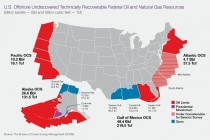
Enlarged
Sincerely,
Jack Gerard
President and CEO
API



